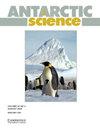南方巨型海燕的栖息地选择:南极半岛潜在的环境监测者
IF 2
4区 地球科学
Q3 ENVIRONMENTAL SCIENCES
引用次数: 0
摘要
南部巨型海燕(Macronectes giganteus)是南大洋分布广泛的顶级捕食者。为了确定南极繁殖种群的精细觅食区域和栖息地使用,在2019-2020年和2021-2022年夏天,对纳尔逊岛的47只南部巨型海燕进行了全球定位系统跟踪。采用分步选择分析法检验了环境变量对生境选择的影响。还分析了与海豹打捞地点和捕鱼区的视觉重叠。鸟类主要生活在威德尔和贝灵斯豪森海域殖民地以南的水域。雌性的分布范围更广,高达纳尔逊岛以西-70°S,而雄性主要集中在南极半岛北部海域。两性的栖息地选择都与水深和企鹅群落的远近有关。两者的觅食区都与捕鱼地点重叠,雌性尤其与南极洲的齿鱼渔场和巴塔哥尼亚大陆架的捕鱼区重叠。由于它们的栖息地关联性和与渔业的重叠,当使用追踪设备和动物携带的摄像机时,巨型海燕可以作为平台,在南极洲的各种时间和空间尺度上监测企鹅群落的状况和发生、拖运地点和不受监管的渔业。本文章由计算机程序翻译,如有差异,请以英文原文为准。
Habitat selection of southern giant petrels: potential environmental monitors of the Antarctic Peninsula
The southern giant petrel (Macronectes giganteus) is a widely distributed top predator of the Southern Ocean. To define the fine-scale foraging areas and habitat use of Antarctic breeding populations, 47 southern giant petrels from Nelson Island were GPS-tracked during the summers of 2019–2020 and 2021–2022. Step-selection analysis was applied to test the effects of environmental variables on habitat selection. Visual overlap with seal haul-out sites and fishing areas was also analysed. Birds primarily used waters to the south of the colony in the Weddell and Bellingshausen seas. Females showed a broader distribution, reaching up to -70°S to the west of Nelson Island, while males were mainly concentrated in waters off the northern Antarctic Peninsula. Habitat selection of both sexes was associated with water depth and proximity to penguin colonies. Both overlapped their foraging areas with fishing sites and females in particular overlapped with toothfish fishery blocks in Antarctica and with fishing areas in the Patagonian Shelf. Due to their habitat associations and overlap with fisheries, when harnessed with tracking devices and animal-borne cameras, giant petrels can act as platforms for monitoring the condition and occurrence of penguin colonies, haul-out sites and unregulated fisheries on various temporal and spatial scales in Antarctica.
求助全文
通过发布文献求助,成功后即可免费获取论文全文。
去求助
来源期刊

Antarctic Science
地学-地球科学综合
CiteScore
3.60
自引率
6.20%
发文量
42
审稿时长
3 months
期刊介绍:
Antarctic Science provides a truly international forum for the broad spread of studies that increasingly characterise scientific research in the Antarctic. Whilst emphasising interdisciplinary work, the journal publishes papers from environmental management to biodiversity, from volcanoes to icebergs, and from oceanography to the upper atmosphere. No other journal covers such a wide range of Antarctic scientific studies. The journal attracts papers from all countries currently undertaking Antarctic research. It publishes both review and data papers with no limits on length, two-page short notes on technical developments and recent discoveries, and book reviews. These, together with an editorial discussing broader aspects of science, provide a rich and varied mixture of items to interest researchers in all areas of science. There are no page charges, or charges for colour, to authors publishing in the Journal. One issue each year is normally devoted to a specific theme or papers from a major meeting.
 求助内容:
求助内容: 应助结果提醒方式:
应助结果提醒方式:


